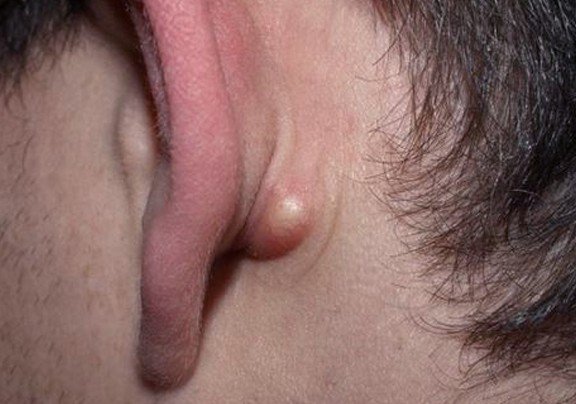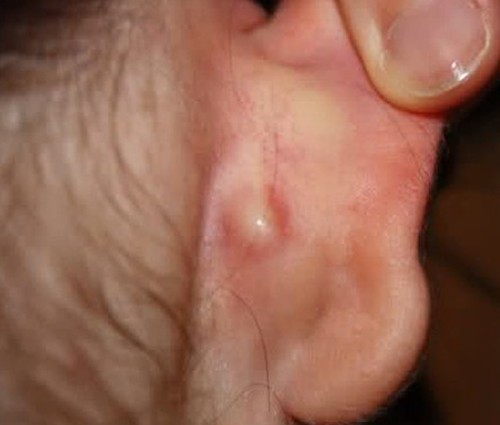Lump in Earlobe
What does Lump in your Earlobe mean?
A lump or cyst in the earlobe is referred to as benign ear cyst. It can also be referred to as a bump, nodule or tumor. It is often non-cancerous and may signal a need for medication in the case of an infection. Rarely, these cysts are a sign of dangerous or life-threatening condition.
Lumps may also be found behind the ear and in the ear canal. Depending on the cause, an ear lump can be single or multiple, painful or painless, soft or firm.
Causes of lumps in the Earlobe
The exact cause of lumps in the earlobe is unknown. However, they may occur when the production of oils in a skin gland overwhelms the rate at which they are released from the gland.
Ear lumps caused by local infectious causes may appear as boils or abscesses. They are usually temporary and subside as the underlying conditions are treated. Those associated with a head injury may signal bleeding in the brain and are often life-threatening. As a result, it is advisable to seek immediate medical care if you have a lump near your ear resulting from a head injury.
Several conditions that may lead to lumps include:
Abscess
An abscess develops in the case of an infection of the tissue or cells in the earlobe, and it is often painful and warm to the touch. Biologically, your body can kill off the invading bacteria or virus causing an infection. The body generates white blood cells that begin accumulating in the damaged location and pus begins to develop from the dead blood cells resulting in cysts.
Sebaceous Cysts
Sebaceous cysts mainly develop around the sebaceous gland. Sebaceous gland produces oil that lubricates your skin as well as hair. This kind of cyst is not painful but may be uncomfortable and also irritating.
Lymphadenopathy
Lymphadenopathy causes the lymph nodes to swell as a result of an infection. Lymph nodes are tiny, organ line structures that are not only present behind the gears but also under the arms, in the neck, and the pelvis. Swollen lymph nodes can also be caused by inflammation or cancer.
Acne Vulgaris
Acne, a common condition of the skin, is caused by the clogging of hair follicles in the skin. The clogging of the hair follicles occurs as a result of dead skin cells and too much oil. With acne, pimple and solid bumps often grow to be large and are sometimes painful.
Throat infection
Throat infection occurs as a result of bacterial or viral infections and is classified into two types; strep throat and infectious mononucleosis. The infection can also be caused by various conditions including HIV/AIDs, measles as well as chicken pox. It is often characterized by a swelling in and around the neck.
Mastoiditis
An untreated ear infection may develop a more serious infection known as the mastoiditis. This type of infection affects the mastoid, the bony protrusion behind the ear. It is characterized by a pus-filled cyst, and one can feel the lumps behind the year.
Otitis Media
Otitis media is a synonym of an ear infection. It can either be bacterial or viral, and it is characterized by painful fluid buildup as well as a visible swelling behind the ear. This kind of infection can be treated using antibiotics.
Other causes include:
- Herpes virus infection
- Mononucleosis
- Upper respiratory virus infections such as common cold
Tumors that can result to ear lumps
- Fibroma
- Lipoma
- Lymphoma
- Melanoma
- Nevi
- Nonmelanoma skin cancer
Symptoms occurring with an ear lump
- Itching
- Pus or discharge
- Tenderness or pain
- Redness, warmth or swelling
- Ear discomfort
Other symptoms associated with an ear lump include
- Cough
- Fever and chills
- Headache
- Sore throat
- Sweating
- Joint stiffness and pain
- Sweating
- Unexplained weight loss
- Serious symptoms indicating a life-threatening condition
In various cases, an ear lump may be accompanied with other symptoms that may call for an emergency medical care. Such symptoms include:
- Unconsciousness or unresponsiveness
- Confusion, lethargy, hallucinations, delusions or delirium
- Profuse or uncontrollable bleeding
- Gradual hearing loss in one year
- Severe outer ear infections
Pictures of Lump in Earlobe
Images and Pictures of lump in earlobe…
Exams and tests
Lumps in the earlobe are often discovered during a routine ear exam including audiometry, a hearing test and tympanometry, a middle ear testing. The condition may also be found during Caloric stimulation and electronystagmography.
Diagnosis
During the diagnosis of an ear lump, the practitioner may ask:
- How long you have had the ear lump
- What symptoms you are experiencing
- If the ear lump is changing in size
- If you are experiencing some sorts of pain around the earlobe
- Potential complications resulting to ear lump
Long-term Complications
Left untreated, ear lumps due to cancer may have long-term consequences. Those caused due to abscesses or other serious infections may lead to widespread infections in the body. Other long term conditions include:
- Ear infection
- Spread of cancer
- Hearing loss
- Spread of the infection in the body
Treatment
In the case where the cyst does not cause pain or affect hearing, treatment may not be needed. However, if the cyst becomes painful and infected, the cyst may be removed.
There are two ways of removing the cyst: drainage and removal. Drainage involves draining the contents using a small incision in the skin that is usually made at the location of the cyst. In most cases, this option does not completely get rid of the cysts. The cyst may begin to retain the fluid after some time since the membrane of the cyst still remains in the skin.
Permanent removal of ear lumps involves surgery. Surgery is often recommended if the benign tumor is painful, leads to frequent ear infections or interferes with hearing. It involves the permanent removal of the contents of the cyst and also its membrane from a small incision.
In some cases, surgery may be complicated by profuse bleeding, infection of an allergic reaction to the anesthetic. Other side effects likely to arise from the surgery include hearing impairments, vertigo, and damage to the facial nerve or perforation of the eardrum
After care
Once the treatment is done, a patient is given corticosteroid and antibiotics to help with the healing of the skin. The ear canal is also packed with materials and ointments to enhance the healing process.
Hearing tests can also be done for two to three months to monitor the condition.


